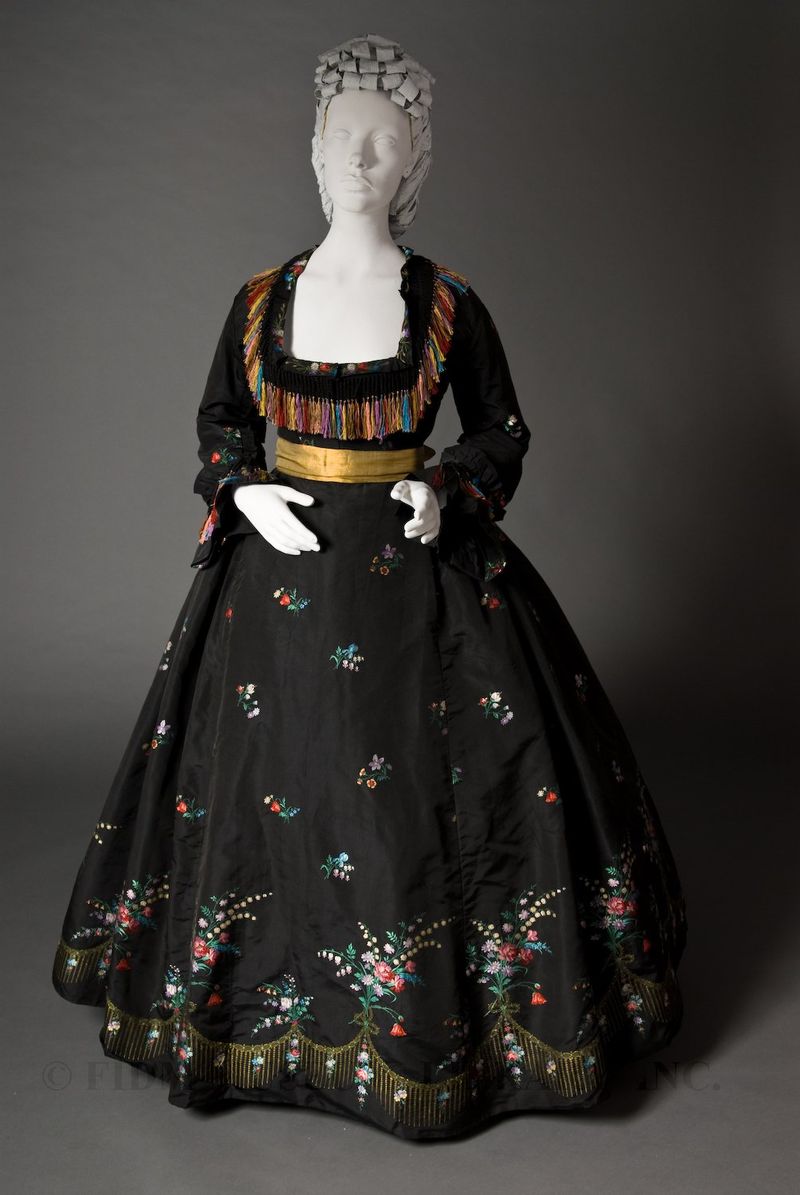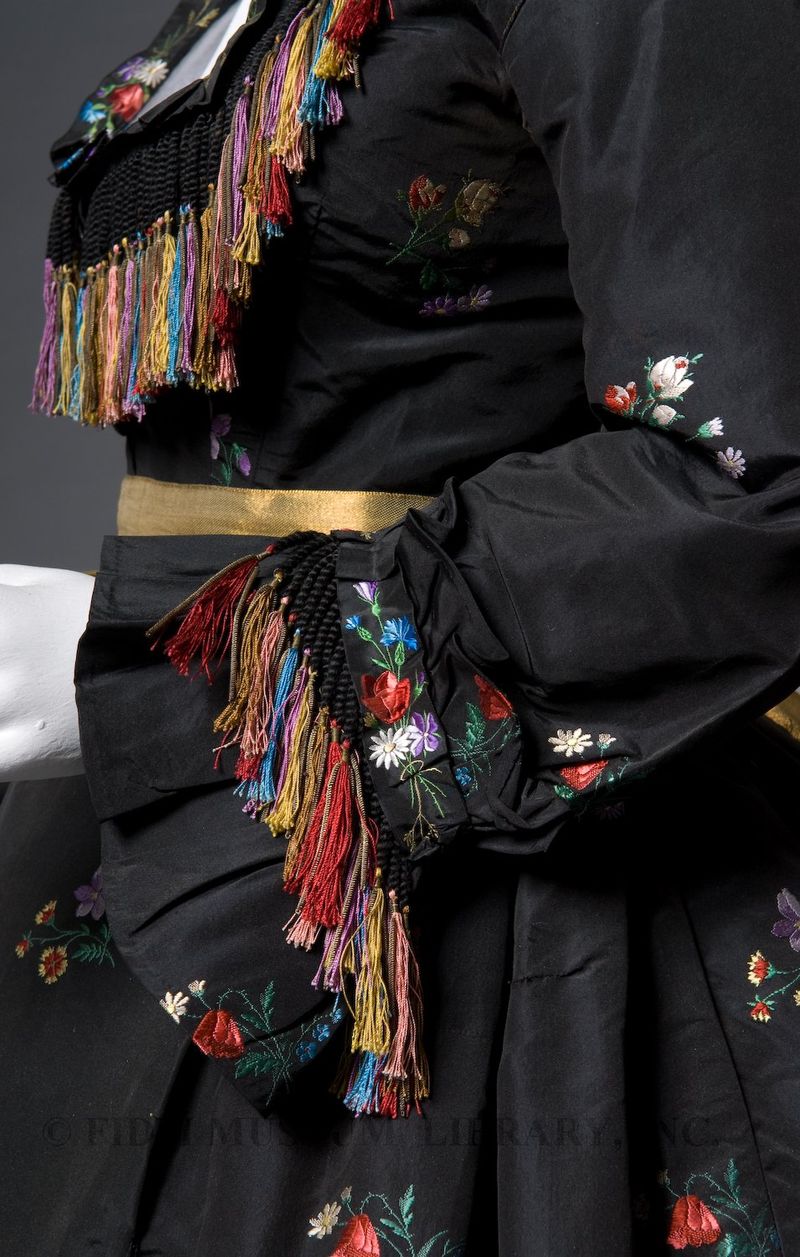 Evening gown
Evening gown
c.1866
Brocaded silk taffeta
Gift of Cathy Gordon
2007.893.1AB
This black silk faille two-piece dress was worn by an unknown woman in approximately 1866. Though it appears extremely formal and elegant to our contemporary eyes, it would have been worn to a dinner or reception, rather than the most formal of evening balls. The black ground creates a luxurious contrast to the multicolored floral sprays, which feature poppies, roses and bleeding hearts among other flowers. Perhaps most compelling is the multicolored silk fringe which frames the bodice and cuffs while echoing the gold brocade swags and floral sprays along the hem.
Though the visual qualities of the dress were enough to overwhelm the Museum staff, we were also thrilled that the dress bears a label. An inner label of silk petersham ribbon stamped with gold ink indicates that the dress was created by Madame Olympe, of 154 Canal Street in New Orleans. As the practice of associating a particular designer with a garment via a label was just beginning in 1866, we were VERY excited to have this additional information.
Using the label as a starting point, FIDM Museum curator Kevin Jones compiled existing research on Madame Olympe and conducted his own research into her life and times. He learned that Olympe Boisse was a native of France who lived and worked in New Orleans, becoming an importer of French millinery goods, or a modiste. Her career began in 1853 when she took over the business of A. Mace, who had been importing French millinery goods. By 1858, Madame Olympe had expanded her business to include dresses, lace and other necessary items for a lady of fashion.
According to a business directory, Madame Olympe’s shop was very popular and featured the most fashionable items in the city. Madame Olympe’s business was most likely closed during the Civil War, when a blockade prevented nearly all dress and textile goods from reaching the American south. Her business reemerged after the Civil War and prospered until 1885 or 1886, after which it was no longer listed in business directories.
Kevin presented his research in a paper titled “A French Modiste in an American City: Olympe Boisse & New Orleans” at the 2008 Costume Society of America Symposium in New Orleans. Have you ever heard of Madame Olympe, or seen a similar dress? If so, please let us know! We’d love to know more about her.




I wanted The Museum at FIT to buy this when it came up for auction a few years back- so glad you got it!
Clare
We’re so fortunate to have this in our collection. Come and visit her in person sometime!
Madame Olympe is mentioned in Elizabeth Custer’s Tenting on the Plains (1887), regarding a visit to New Orleans: “We had come on board almost wrecked in our finances by the theatre, the tempting flowers, the fascinating restaurants, and finally, a disastrous lingering one day in the beguiling shop of Madam Olympe, the reigning milliner. The General had bought some folly for me . . .” This was one of the memoirs she published after the general’s death at the Little Big Horn.
William, thanks so much for sending us this fascinating reference to Madame Olympe! We’ll add the citation to our files.
Is there any way I can get a copy of the paper? I am interested in Olympe. Thanks
Katherine, if you’d like a copy of Kevin’s paper, email me directly at rharris@fidmmuseum.org.
Wow! Definitely one of my favorites of the era. Can you tell me if the flowers are woven in or embroidered?
Hi Beth,
The floral pattern is a brocade, woven into the textile during the manufacturing process.
I think my “favourites” list just got a new entry.
I just came across my old research on this woman. I started that back in the 1980s when I lived in New York and came across one of her gowns. I’m packing up all that’s left of that research so the museum there will have it to store with that gown. Small world – who would have thought over 25years ago she’d be on the web!
I did research on her in the mid 1980s. Who would have thought she’d be on the web over 25yrs later.
Would it still be possible to get s copy of the reasesrch paper? I have so many questions about this amazing dress!
Hi Jessica! Thank you so much for your interest in the research paper; unfortunately we can’t share the entire paper, but if you have any specific questions please feel free to email us at at info@fidmmuseum.org!
How does the bodice close? The fringe and sash cover the front and there is no image of the back. Thank you.
Hi Jessica, thank you for your question. The bodice hooks up the center front.
Do you still have access to the research paper? I’d be interested in reading it! Thank you.
Hi Emily, thank you for your interest in the research paper; unfortunately, we can’t share the entire paper, but if you have any specific questions please feel free to email us at info@fidmmuseum.org!
I know of Madame Olympe because I work at a museum in New Orleans. Once upon a time, I was reading a 19th-cent. article from a national publication (NY Times? Harper’s Weekly?) that was commenting on ladies’ fashions, and mentioned “Olympe.” I wondered if the author could possibly have been referring to New Orleans’s own modiste, but I thought, nah–she couldn’t have been that well known. I guess she probably was nationally famous, though. Before the war, New Orleans was the 3rd-largest city in the US and was THE place for the southern elite to shop.